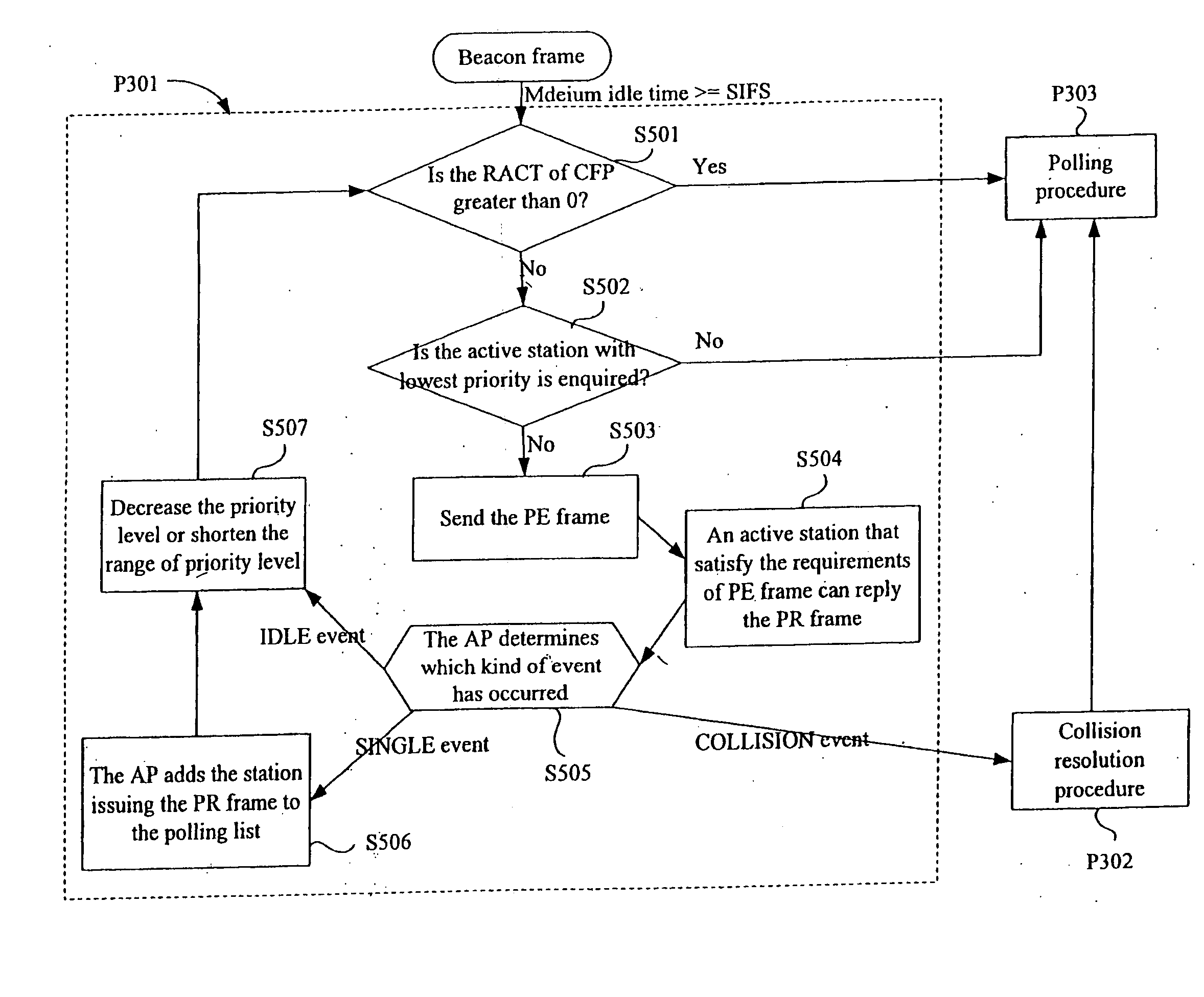[0009] The basic building block of the WLAN is the
cell, also known as the
basic service set (BSS) defined in IEEE 802.11 specification. A BSS is composed of a central
base station, known as an access point (AP), and a finite set of mobile stations (or called stations) such as
wireless phones, laptops, or other devices with wireless communication functions. Mobile stations can operate either in the
active mode or the power-saving (PS) mode. In IEEE 802.11, a station should associate with an AP (or reassociate with a new AP) to become a member of an infrastructure BSS. When the association request is granted, the AP responds with a status code of 0 (successful) and the Association ID (AID). The AID is an integer identifier used to logically identify the
mobile station. The AP can thus maintain a
list of finite stations associated within its BSS and updates it whenever a new station joins or a station leaves the BSS. However, the present invention allows the AP or mobile stations to disable the CF-Pollable and CF-Poll Request subfields of the Capacity
Information field in (re)association request frames. Instead, the invention provides a new reservation method such that stations are able to get on / off the polling list quickly and efficiently without relying on the (re)association.
[0011] In the present invention, as depicted in FIG. 2, the CFP is further divided into three periods: the prioritization period, the collision resolution period, and the polling period. The first two periods are together called the registration period. During the prioritization period, the AP performs a series of handshakes to guarantee that high-priority stations are always admitted to the polling list earlier than low-priority stations. During the collision resolution period, the AP performs a deterministic tree-splitting
algorithm to probe which stations undergo the prioritization period desire to join the polling list. Once the registration process terminates, the AP broadcasts a V-POLL frame to announce the start of the polling period. The V-POLL frame contains a vector list and each vector is composed of a yet-to-be-polled station, its intended
receiver, and the granted TXOP. Upon examining the V-POLL frame, a PS station that can be neither a sender nor a
receiver during the polling period may reenter to the doze state. Note that, in the doze state, a station is unable to transmit or receive but consumes very low power. After the end of the polling period, the PC broadcasts the CF-End frame to let all stations reset their NAV and enter the CP. Since the length of CFPMaxDuration is limited, the overrun of the registration process may shorten the polling period, thus violating the quality of already-admitted connections. Hence a new run-time
admission control method is invented to assist the AP in determining when the registration period should be terminated. In particular, when the polling list size reaches saturation point, the AP may directly dive into polling period at the start of the CFP without first performing the
registration procedure. A surprising phenomenon in VPCF is that collisions may occur in the CFP. However, during the entire CFP, associated stations can transmit frames only when they are allowed to do so by the AP. Consequently, the AP can control these collisions effectively and without
chaotic events.
[0017] In the invention, if a power-saving (PS) station finds that its AID is not in the V-POLL frame, then that PS station can return to the doze state. On the other hand, each polled station needs to keep track of the channel activity and automatically initiates its transmission a SIFS period after the end of the transmission of its predecessor in the polling order. To conserve energy, a PS station that will be either a sender or a
receiver during the polling period may remain in the awake state for only a portion of the polling period through the time that the PS station finishes sending or receiving data frames. To minimize the average time spent awake, in the invention, the AP adopts the shortest-job-first policy proposed to schedule the poll records, wherein the job size corresponds to the aggregate TXOP.
[0020] In summary, as compared to the prior methods (802.11 standard and 802.11e draft), the invention has the following advantages:
[0023] (3) In the invention, the AP allocates the proper TXOP to each polled station according to its declared dTXOP and gTXOP. By this way, the invention can provide per-flow probabilistic performance assurances.
[0025] (5) The invention achieves power conservation via the following three approaches: (a) in contrast with contention MAC protocols (e.g., the DCF in 802.11 or the EDCA in 802.11e), the invention adopts the reservation and polling access methods to reduce unnecessary collisions and retransmissions as far as possible; (b) the invention uses the V-POLL frame to let power-saving (PS) stations which cannot partake in the polling process immediately return to the doze state; (c) the invention employs the power-conserving scheduling
algorithm such that PS stations which will partake in the polling process can spend as little awake time as possible.
 Login to View More
Login to View More  Login to View More
Login to View More 


